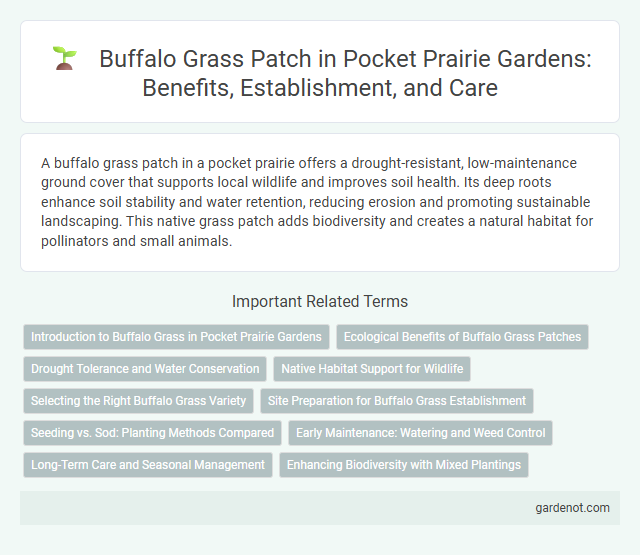A buffalo grass patch in a pocket prairie offers a drought-resistant, low-maintenance ground cover that supports local wildlife and improves soil health. Its deep roots enhance soil stability and water retention, reducing erosion and promoting sustainable landscaping. This native grass patch adds biodiversity and creates a natural habitat for pollinators and small animals.
Introduction to Buffalo Grass in Pocket Prairie Gardens
Buffalo grass (Bouteloua dactyloides) is a native warm-season grass ideal for pocket prairie gardens due to its drought tolerance and low maintenance requirements. This perennial grass adapts well to various soil types and provides excellent ground cover, promoting biodiversity by supporting local pollinators and wildlife. Incorporating Buffalo grass into pocket prairies enhances ecosystem resilience while reducing water usage.
Ecological Benefits of Buffalo Grass Patches
Buffalo grass patches significantly enhance soil health by reducing erosion and improving water retention through their dense root systems. These native grasses provide critical habitat and food sources for pollinators, birds, and beneficial insects, promoting biodiversity within pocket prairies. Their low water and maintenance requirements contribute to sustainable landscaping, conserving resources while supporting ecological balance.
Drought Tolerance and Water Conservation
Buffalo grass patch is highly drought-tolerant, thriving in arid climates with minimal supplemental watering. Its deep root system enhances water conservation by efficiently accessing and retaining soil moisture. This grass variety significantly reduces water usage, making it ideal for sustainable landscaping in pocket prairies.
Native Habitat Support for Wildlife
Buffalo grass patches within pocket prairies create essential native habitats that support diverse wildlife by providing food, shelter, and nesting sites. These patches sustain pollinators, birds, and small mammals by mimicking natural prairie ecosystems. Maintaining buffalo grass enhances biodiversity and promotes ecological balance in urban and rural environments.
Selecting the Right Buffalo Grass Variety
Choosing the right buffalo grass variety for a pocket prairie ensures optimal growth, drought tolerance, and ecosystem benefits. Popular varieties like 'Prestige' and 'Matt' thrive in diverse climates and support native pollinators, making them ideal for sustainable landscaping. Selecting a variety matched to soil type and regional conditions maximizes soil health and biodiversity.
Site Preparation for Buffalo Grass Establishment
Site preparation for Buffalo grass establishment requires thorough soil evaluation to ensure a well-drained, fertile substrate with a pH ranging from 6.0 to 7.5. Clear existing vegetation and debris, then perform light tilling or aeration to create a fine, firm seedbed that promotes seed-to-soil contact. Incorporate organic matter or starter fertilizer rich in nitrogen and phosphorus to enhance germination and root development in the Pocket prairie setting.
Seeding vs. Sod: Planting Methods Compared
Buffalo grass can be successfully established using seeding or sod, each method offering distinct advantages. Seeding is cost-effective and allows for extensive coverage in large areas, but requires longer time for establishment and careful moisture management. Sod provides immediate ground cover, reducing erosion and weed invasion, but involves higher initial costs and labor for installation.
Early Maintenance: Watering and Weed Control
Early maintenance of a Buffalo grass patch requires consistent watering to establish deep root growth, ideally providing 1 inch of water per week through irrigation or rainfall. Effective weed control during this period involves manual removal or the use of selective herbicides safe for Buffalo grass to prevent competition for nutrients and water. Proper early care enhances drought tolerance and promotes a dense, healthy turf.
Long-Term Care and Seasonal Management
Maintaining a Buffalo grass patch requires careful long-term care, including minimal mowing to preserve its drought-resistant qualities and prevent soil erosion. Seasonal management involves adjusting watering schedules, with more frequent irrigation during establishment in spring and reduced watering in summer to promote deep root growth. Fertilization should be limited to early spring applications, avoiding excess nitrogen that can weaken grass resilience over time.
Enhancing Biodiversity with Mixed Plantings
Buffalo grass patch planted within pocket prairies significantly enhances biodiversity by providing habitat and food sources for native insects, birds, and small mammals. Integrating buffalo grass with wildflowers and native grasses creates a resilient ecosystem that supports pollinators and improves soil health. This diverse plant community reduces erosion and fosters ecological balance, contributing to sustainable landscape management.
Buffalo grass patch Infographic

 gardenot.com
gardenot.com